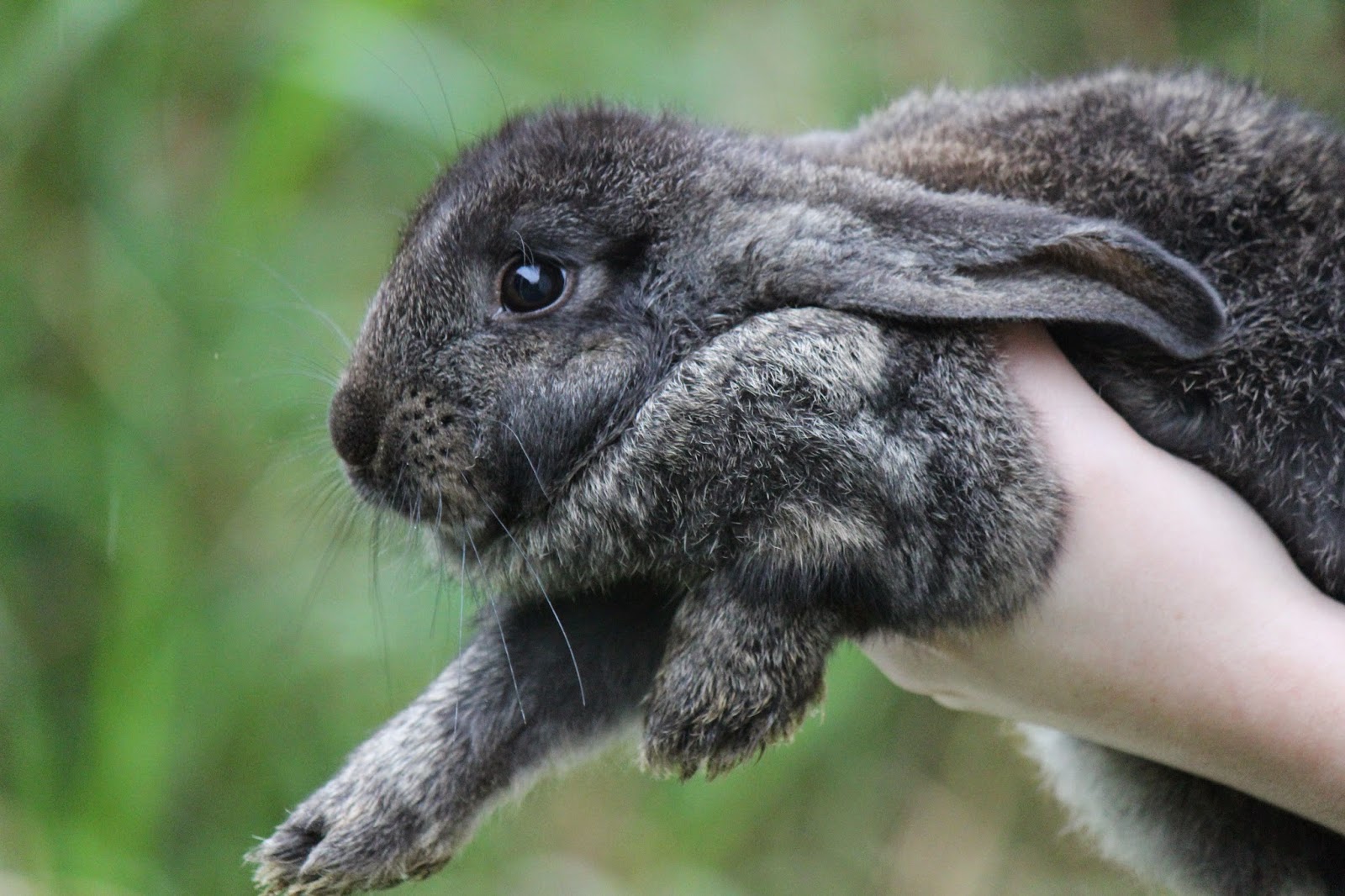We decided on a really hardy breed that will do well in the cold and hold their own against the chickens if they decided to be bullies. Flemish giants are as the name implies - giant! We got two males so that we wouldn't end up with any accidental babies. Maybe someday we will look into breeding them.
They are super friendly and very interested in the chickens. They follow them around and inspect them while the chickens run away! It is pretty funny to see how high our hens can fly when they get spooked by these cuddly little bunnies. Our Flemish Giants are "sandy" colored. Caleb named them "Alhe" and "Rombi"!
About the Breed
Size: Minimum weight (after 8 months old) is 13 pounds. No maximum weight. They also have a minimum length requirement of 21 inches - they are the only breed to have a requirement on length.
Recognized colors: There are seven different colors within the Flemish Giant standard. They are Black, Blue, Fawn, Light Gray, Steel Gray, White and Sandy. ARBA Standard states the colors should be:
Black—The surface color shall be solid black. The undercolor shall be slate blue. Eyes—Brown. Faults—Ticking; brownish cast.
Blue—The surface color shall be dark blue. The undercolor shall be slate blue. Eyes—Blue-gray. Faults—Ticking; brownish cast; ear lacing.
Fawn—The surface color shall be a rich. Golden straw color. The undercoat shall blend to a pale cream next to the skin. Belly surface color, undercoat, and underside of tail shall be light cream to white. Crotch marks are accepted. Eyes—Brown. Faults—Ticking; excessively wide eye circles; light patches on any part of the body color; ear lacing; smut; reddish belly color.
Light Gray—The surface color shall be a uniform light gray, with ticking of black tipped guard hairs. It shall be an agouti coat, with distinct bands visible when blowing into the coat. The undercoat shall be slate blue next to the skin, and there shall be an intermediate band of off-white. Belly surface color shall be white, with slate blue undercolor. Crotch marks are accepted. Underside of the tail shall be a continuation of the belly surface color. Eyes—Brown. Faults—Dark gray belly surface color; sandy or brassiness in surface color.
Sandy—The surface color shall be a reddish sandy. Interspersed with contrasting dark ticking. The undercolor shall show a brassy reddish intermediate color with slate blue undercolo next to the skin. The ears shall be laced with black. The belly and underside of the tail shall be cream to white, except for crotch marks. Eyes—Brown. Faults—Heavy, dark ticking; smudgy or patchy color. Slate blue belly undercolor is permissible, but not desirable.
Stell Gray—Surface color shall be a black steel gray, with a moderate amount of light gray tipped guard hairs evenly distributed. This color shall be even over the entire body. Including head, ears, feet, and legs. Undercolor shall be slate blue, carried down to the skin. Belly surface color shall be white as possible, with slate blue undercolor. Underside of tail shall be a continuation of belly surface color. Crotch marks are accepted. Eyes—Brown. Faults—Brownish cast; black patches; belly color similar to balance of body. Disqualification from Competition—Ring color over the back. (Slight ring color on the lower part of the body permissible.)
White—Color shall be pure white throughout. Eyes—Pink. Faults—Yellow case; stains.
General Appearance: Should be well balanced, not fat. Long but proportionate. Females (called Does) may have a large dewlap. Ears should have a broad base and be at least 6 inches in length.
Lifespan: 5-7 years - note that obesity will shorten their lifespan.
Breeding: They are considered sexually mature when they reach adult size between 9 and 12 months of age. A typical gestation period for a rabbit is 28-32 days but the Flemish Giant can be up to 35 days. They have large litters (5-12 kits).
History: A great article called Origins of the Flemish Giants By Thomas Coatoam investigates the origins of the Flemish Giant. They, like many old breeds, have a controversial origin. What the author was certain of though, as stated in the article, is:
For more information refer to the National Federation of Flemish Giant Breeder's Website. Please share your Flemish Giant stories, pictures and videos!
May 8th Update:
June 3rd Update:
August 9th Update
Evee our new little girl Flemish Giant. She is much lighter than our two boys. Each of our bunnies have their own home now since they can't be left alone together. Eevee is too young and we don't want to end up with babies! They do get to play for a bit under close supervision though.









August 28th
I didn't get any pictures of Rombi this time. We can only have one boy out at a time unfortunately. It is sad that their brotherly love couldn't win out of their testosterone but to keep them safe we keep them separated.
I tried getting a few pictures to show you the size difference between Alhe and our new addition Eevee but the pictures don't do them justice. Alhe is huge and was able to jump right out of the exercise pen made for dogs. Eevee is about "regular" bunny size and she is just a few months old!




















wow cute your flemish giant steel color.
ReplyDeletekelinci